Effects of Low-Impact Development Facilities (Water Systems of the Park) on Stormwater Runoff in Shallow Mountainous Areas Based on Dual-Model (SWMM and MIKE21) Simulations
Abstract
1. Introduction
2. Materials and Methods
2.1. Study Area
2.2. Data Collection
2.3. Research Methods
2.3.1. Runoff Control Objective Identification
2.3.2. Calculation of Runoff Abatement from Internal and External Sources in the Area
2.3.3. Rainfall Conditions of the Simulation Scheme
2.3.4. SWMM Model Construction
- Pre-Construction Stormwater Modeling
- 2.
- Post-Construction Stormwater Modeling
2.3.5. MIKE21 Modeling before and after Construction
- (a)
- MIKE21 Pre-Construction Stormwater Modeling
- (b)
- MIKE21 Post-Construction Stormwater Modeling
2.3.6. Calibration of the Constructed SWMM Model and MIKE21 Model with Measured Data
3. Results
3.1. Peak Flow Rate
3.2. Outflow Volume
3.3. Rainfall–Outflow Ratio
3.4. Runoff Velocity
3.5. Waterscape Area of Water System
4. Discussion
5. Conclusions
- (1)
- In terms of flood risk, LID facilities can effectively reduce the peak flow rate of mountain rainwater runoff and delay the time of peak flow, as well as the outflow volume and the rainfall–outflow ratio, thus enhancing the ability of the catchment area to absorb and maintain rainwater. This can effectively reduce the maximum current speed in most sites. Further analysis shows that the design standard for waterlogging control in shallow mountain areas should also include a return period of more than 30 years.
- (2)
- In the area of recycling rainwater for water landscape creation, the setting of LID facilities can effectively collect rainwater, become a supplement to the landscape water system in the site, and meet the water landscape requirements of “the Expo Park”. Furthermore, the simulation of the submerged process can effectively predict the submerged range of the waterscape in the design site under different rainfall conditions, which has certain reference value for waterscape design.
Author Contributions
Funding
Institutional Review Board Statement
Informed Consent Statement
Data Availability Statement
Acknowledgments
Conflicts of Interest
References
- Kuang, W.; Yang, T.; Yan, F. Examining urban land-cover characteristics and ecological regulation during the construction of Xiong’an New District, Hebei Province, China. J. Geogr. Sci. 2018, 28, 109–123. [Google Scholar] [CrossRef]
- Su, W.; Ru, J.; Yang, G. Modelling stormwater management based on infiltration capacity of land use in the watershed scale. Acta Geogr. Sin. 2019, 74, 948–961. [Google Scholar]
- Hollis, G. Water yield changes after the urbanization of the canon’s brook catchment, harlow, england/Changements de l’apport d’eau à la suite de l’urbanisation du bassin versant de ‘Canon’s Brook’à Harlow, en Angleterre. Hydrol. Sci. J. 1977, 22, 61–75. [Google Scholar] [CrossRef]
- Jennings, D.B.; Taylor, J.S. Changes in anthropogenic impervious surfaces, precipitation and daily streamflow discharge: A historical perspective in a mid-Atlantic subwatershed. Landsc. Ecol. 2002, 17, 471–489. [Google Scholar] [CrossRef]
- Ji, C.; Li, L. Research on sponge city construction in Lin Yi city. In Proceedings of the International Conference on Education, Management, Computer and Society; Atlantis Press: Shenyang, China, 2016; pp. 1818–1821. [Google Scholar]
- Wang, K. Research and Discussion on the Current Situation and Problems of Sponge City Construction. Value Eng. 2022, 41, 11–13. [Google Scholar]
- Ministry of Housing and Urban-Rural Development of the People’s Republic of China. Beijing, China. Carry Out the Second Batch of Systematic and All-Round Demonstration Work of Sponge City Construction during the “14th Five Year Plan”. Available online: https://www.mohurd.gov.cn/xinwen/gzdt/202204/20220415_765693.html (accessed on 16 October 2022).
- Notice on Carrying Out the Demonstration Work of Systematically and Comprehensively Promoting the Construction of Sponge Cities. Available online: http://yn.mof.gov.cn/tongzhitonggao/202203/t20220329_3799276.htm (accessed on 12 September 2022).
- Ministry of Housing and Urban-Rural Development of the People’s Republic of China. Notice on Carrying Out Demonstration Work of Systematically Promoting Sponge City Construction. Available online: http://www.gov.cn/zhengce/zhengceku/2021-04/26/content_5602408.htm (accessed on 31 October 2022).
- Ministry of Housing and Urban-Rural Development of the People’s Republic of China. Technical Guide for Sponge City Construction: Rainwater System Construction for Low Impact Development (Trial). 2014. Available online: https://www.mohurd.gov.cn/gongkai/fdzdgknr/zfhcxjsbwj/201411/20141103_219465.html (accessed on 15 September 2022).
- Baek, S.-S.; Choi, D.-H.; Jung, J.-W.; Lee, H.-J.; Lee, H.; Yoon, K.-S.; Cho, K.H. Optimizing low impact development (LID) for stormwater runoff treatment in urban area, Korea: Experimental and modeling approach. Water Res. 2015, 86, 122–131. [Google Scholar] [CrossRef]
- Rosa, D.J.; Clausen, J.C.; Dietz, M.E. Calibration and verification of SWMM for low impact development. JAWRA J. Am. Water Resour. Assoc. 2015, 51, 746–757. [Google Scholar] [CrossRef]
- Bedan, E.S.; Clausen, J.C. Stormwater runoff quality and quantity from traditional and low impact development watersheds 1. Jawra J. Am. Water Resour. Assoc. 2009, 45, 998–1008. [Google Scholar] [CrossRef]
- Yang, Y.; Guangsi, L. A Review on Sponge City. South Archit. 2015, 167, 59–64. [Google Scholar]
- Wang, L.; Yang, F.; Wang, C.; Cui, J.; Xu, Y.; Zhao, G.; Cui, S. Study on Low Impact Development Mode Based on SWMM Model in Urban Rainwater Flood Control. China Rural. Water Hydropower 2019, 435, 83–86. [Google Scholar]
- Huang, G.; Mai, Y.; Li, B.; Zeng, J.; Wu, H.; Zhang, M. Hydrological Effect of Sponge Reconstruction of Typical Communities in Guangzhou Based on PCSWMM Model. South Archit. 2017, 179, 38–45. [Google Scholar]
- Ahiablame, L.; Shakya, R. Modeling flood reduction effects of low impact development at a watershed scale. J. Environ. Manag. 2016, 171, 81–91. [Google Scholar] [CrossRef]
- Zhang, Y.; Hao, M.; Fang, Q.; Lu, B.; Wang, J.; Pei, Y. Simulation of flood control and drainage in new urban area based on Mike Flood coupling model. China Rural. Water Hydropower 2021, 469, 90–96. [Google Scholar]
- Chen, H. Research on the Planning and Design of Forest-Wetland Park in Foothill Area in Beijing from the Perspective of Rainwater Management—A Case Study ofMiyun Forest-Wetland Park; Beijing Forestry University: Beijing, China, 2020. [Google Scholar]
- Wyżga, B.; Radecki-Pawlik, A.; Zawiejska, J. Flood risk management in the Upper Vistula Basin in perspective: Traditional versus alternative measures. In Flood Risk in the Upper Vistula Basin; Springer: Berlin/Heidelberg, Germany, 2016; pp. 361–380. [Google Scholar]
- Tullos, D.; Byron, E.; Galloway, G.; Obeysekera, J.; Prakash, O.; Sun, Y.-H. Review of challenges of and practices for sustainable management of mountain flood hazards. Nat. Hazards 2016, 83, 1763–1797. [Google Scholar] [CrossRef]
- Guo, X.; Cui, P.; Chen, X.; Li, Y.; Zhang, J.; Sun, Y. Spatial uncertainty of rainfall and its impact on hydrological hazard forecasting in a small semiarid mountainous watershed. J. Hydrol. 2021, 595, 126049. [Google Scholar] [CrossRef]
- Leng, L.; Mao, X.; Jia, H.; Xu, T.; Chen, A.S.; Yin, D.; Fu, G. Performance assessment of coupled green-grey-blue systems for Sponge City construction. Sci. Total Environ. 2020, 728, 138608. [Google Scholar] [CrossRef]
- Ren, G.; Lv, F.; Di, Y. Development Characteristics and Prevention Measures of Debris Flow Disaster in Qinhuangdao. J. EMCC 2010, 20, 35–38. [Google Scholar]
- Danjie, W.; Shengze, Z.; Youhua, L.; Manzhang, T.; Jianyang, Z.; Yingyuan, G.; Haiyang, P. New Trends and Practical Research on the Sponge Cities with Chinese Characteristics. China Soft Sci. 2016, 1, 79–97. [Google Scholar]
- Lihua, S.; Yijun, Q.; Baogui, Z.; Jie, W. The Characteristics of Natural Rainfall in Recent 63 Years in Qinhuangdao. J. HeiBei Univ. Environ. Eng. 2017, 27, 35–38. [Google Scholar]
- Department of Housing and Urban Rural Development of Hebei Province. 2016 Technical Specification for Sponge City Construction Engineering DB13/T210-2016; China Building Materials Industry Press: Beijing, China, 2016. [Google Scholar]
- Grimaldi, S.; Petroselli, A. Do we still need the rational formula? An alternative empirical procedure for peak discharge estimation in small and ungauged basins. Hydrol. Sci. J. 2015, 60, 67–77. [Google Scholar] [CrossRef]
- Wang, Q.; Zhang, X.; Wei, M.; Zhou, Y.; Li, P.; Bai, G. Research summary of planning and design standards for storm water system in Beijing City. Jishui Paishui/Water Wastewater Eng. 2011, 47, 34–39. [Google Scholar]
- Rossman, L.A. Storm Water Management Model User’s Manual, Version 5.0; National Risk Management Research Laboratory, Office of Research and Development, U.S. Environmental Protection Agency: Cincinnati, OH, USA, 2010.
- Hussain, S.N.; Zwain, H.M.; Nile, B.K. Modeling the effects of land-use and climate change on the performance of stormwater sewer system using SWMM simulation: Case study. J. Water Clim. Chang. 2022, 13, 125–138. [Google Scholar] [CrossRef]
- Quanbin, L. Evaluation of Drainage Capacity of LID Schemes Based on SWMM Model; Guangzhou University: Guangzhou, China, 2017. [Google Scholar]
- MIKE21 Parabolic Mild-Slope Wave Module Scientific Documentation. Available online: https://manuals.mikepoweredbydhi.help/2017/Coast_and_Sea/MIKE21PMSscientific.pdf (accessed on 12 September 2022).
- Jiajia, L. Numerical Sinulation of Check Dam Failure Process Based on MIKE21 Model; Xi’an University of Technology: Xi’an, China, 2021. [Google Scholar]
- The Second (Qinhuangdao) Garden Expo of Hebei Province and the First Hebei International Urban Planning and Design Competition Ended Successfully. Zhang Gujiang, Kang Yanmin, Meng Xiangwei, Zhang Ruishu and Others Attended the Closing Ceremony. Available online: http://www.qhd.gov.cn/front_pcthi.do?uuid=C3301ADE636FC38450854DA098978595 (accessed on 12 September 2022).
- Li, D.; Ye, C. Multi-objective Optimization of Low Impact Development Using SWMM Model and NSGA-Method and lts Application. Water Resour. Power 2019, 37, 58–61. [Google Scholar]
- Alizadeh, M.J.; Kavianpour, M.R.; Kisi, O.; Nourani, V. A new approach for simulating and forecasting the rainfall-runoff process within the next two months. J. Hydrol. 2017, 548, 588–597. [Google Scholar] [CrossRef]
- Nie, L.; Jia, H.; Zhang, K.; Fu, G. Assessment Standard for Sponge City Effects; IWA Publishing: Beijing, China, 2020. [Google Scholar]
- Yin, D.; Evans, B.; Wang, Q.; Chen, Z.; Jia, H.; Chen, A.S.; Fu, G.; Ahmad, S.; Leng, L. Integrated 1D and 2D model for better assessing runoff quantity control of low impact development facilities on community scale. Sci. Total Environ. 2020, 720, 137630. [Google Scholar] [CrossRef]
- Lucas, W.C.; Sample, D.J. Reducing combined sewer overflows by using outlet controls for Green Stormwater Infrastructure: Case study in Richmond, Virginia. J. Hydrol. 2015, 520, 473–488. [Google Scholar] [CrossRef]
- Guo, X.; Guo, Q.; Zhou, Z.; Du, P.; Zhao, D. Degrees of hydrologic restoration by low impact development practices under different runoff volume capture goals. J. Hydrol. 2019, 578, 124069. [Google Scholar] [CrossRef]
- Hakimdavar, R.; Culligan, P.J.; Finazzi, M.; Barontini, S.; Ranzi, R. Scale dynamics of extensive green roofs: Quantifying the effect of drainage area and rainfall characteristics on observed and modeled green roof hydrologic performance. Ecol. Eng. 2014, 73, 494–508. [Google Scholar] [CrossRef]
- Stovin, V.; Poë, S.; De-Ville, S.; Berretta, C. The influence of substrate and vegetation configuration on green roof hydrological performance. Ecol. Eng. 2015, 85, 159–172. [Google Scholar] [CrossRef]
- Yang, Y.; Li, J.; Huang, Q.; Xia, J.; Li, J.; Liu, D.; Tan, Q. Performance assessment of sponge city infrastructure on stormwater outflows using isochrone and SWMM models. J. Hydrol. 2021, 597, 126151. [Google Scholar] [CrossRef]
- Guozhi, H. Discrimination of relationship between urban storm waterlogging prevention and sponge city construct. China Flood Drought Manag. 2018, 28, 8–14. [Google Scholar]
- Ministry of Housing and Urban-Rural Development of the People’s Republic of China. Technical Code for Urban Waterlogging Prevention and Control. GB Patent 51222- 2017, 2017, 7.
- Alexander, K.; Hettiarachchi, S.; Ou, Y.; Sharma, A. Can integrated green spaces and storage facilities absorb the increased risk of flooding due to climate change in developed urban environments? J. Hydrol. 2019, 579, 124–201. [Google Scholar] [CrossRef]
- Liu, H.; Guo, C.; Yuan, J.; Jin, Z.; Yi, Y. Dynamic risk assessment and early warning of mountain torrents based on sediment runoff. China Flood Drought Manag. 2022, 32, 20–26. [Google Scholar]
- Song, C.; Wang, H.; Kang, D. Research Progress and Development Trend of Storm Flood Management Model SWMM. China Water Wastewater 2015, 31, 16–20. [Google Scholar]
- Hibbs, B.J.; Sharp, J.M., Jr. Hydrogeological impacts of urbanization. Environ. Eng. Geosci. 2012, 18, 3–24. [Google Scholar] [CrossRef]
- Rauch, W.; Ledin, A.; Eriksson, E.; Deletic, A.; Hunt III, W.F.B. Stormwater in urban areas. Water Res. 2012, 46, 6588. [Google Scholar] [CrossRef]
- Angrill, S.; Petit-Boix, A.; Morales-Pinzón, T.; Josa, A.; Rieradevall, J.; Gabarrell, X. Urban rainwater runoff quantity and quality–A potential endogenous resource in cities? J. Environ. Manag. 2017, 189, 14–21. [Google Scholar] [CrossRef]
- Qi, W. Simulation Study on the Effect of Runoff Regulation and Storage Facilities on Flood Control; Xi’an University of Technology: Xi’an, China, 2019. [Google Scholar]
- Chen, H.; Dong, Y.; Lin, C. Research on Optimization Method of Facility Layout for Low Impact Development of Shallow Mountain Green Space Based on D8 and NSGA-II Coupling Algorithm. J. Beijing For. Univ. 2022, 44, 116–126. [Google Scholar]
- Ruonan, W. Urban Waterlogging Risk Level Assessment Methods and Case Study; Xi’an University of Architecture and Technology: Xi’an, China, 2016. [Google Scholar]
- Zhao, L.; Zhang, T.; Fu, J.; Li, J.; Cao, Z.; Feng, P. Risk Assessment of Urban Floods Based on a SWMM-MIKE21-Coupled Model Using GF-2 Data. Remote Sens. 2021, 13, 4381. [Google Scholar] [CrossRef]





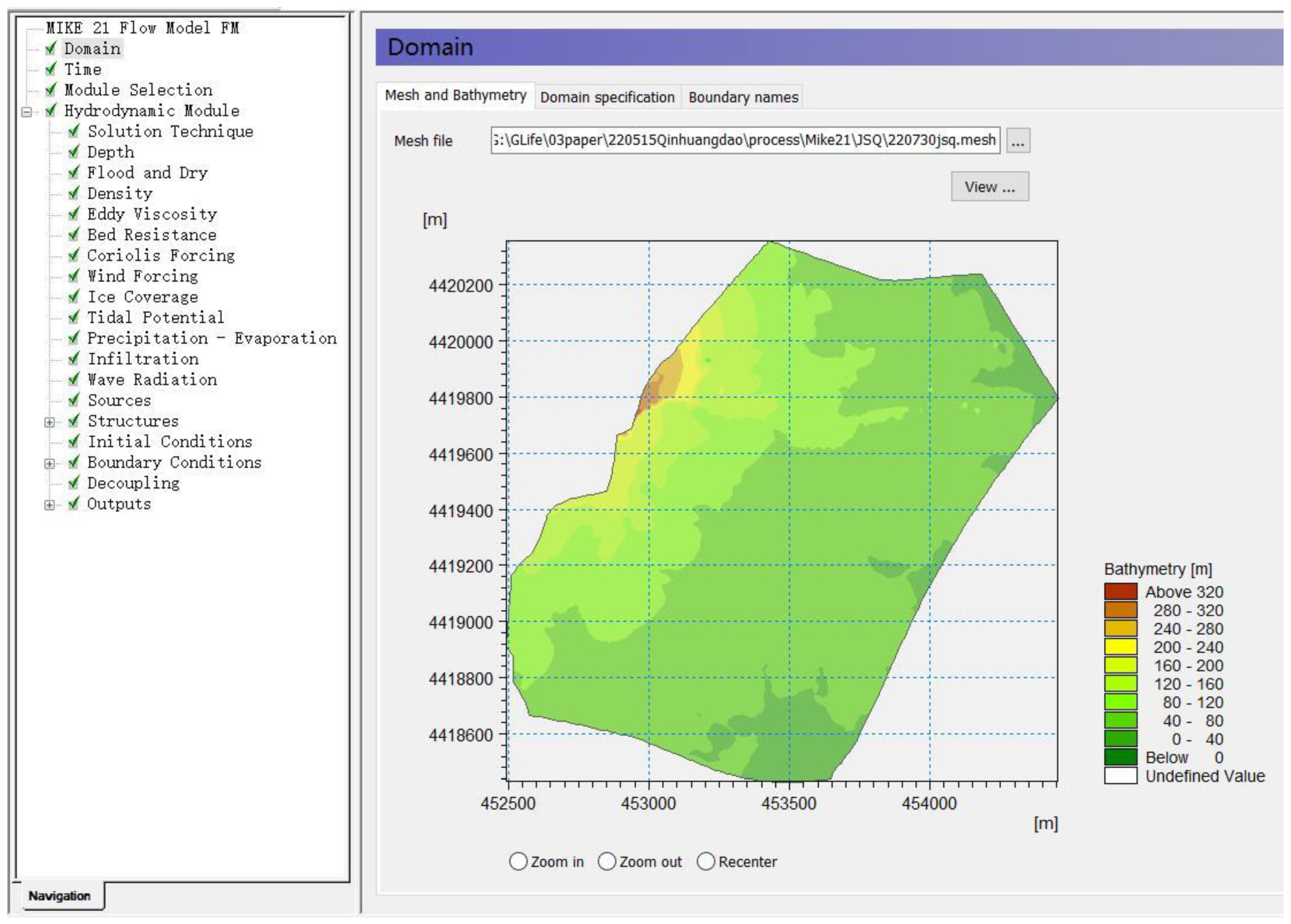
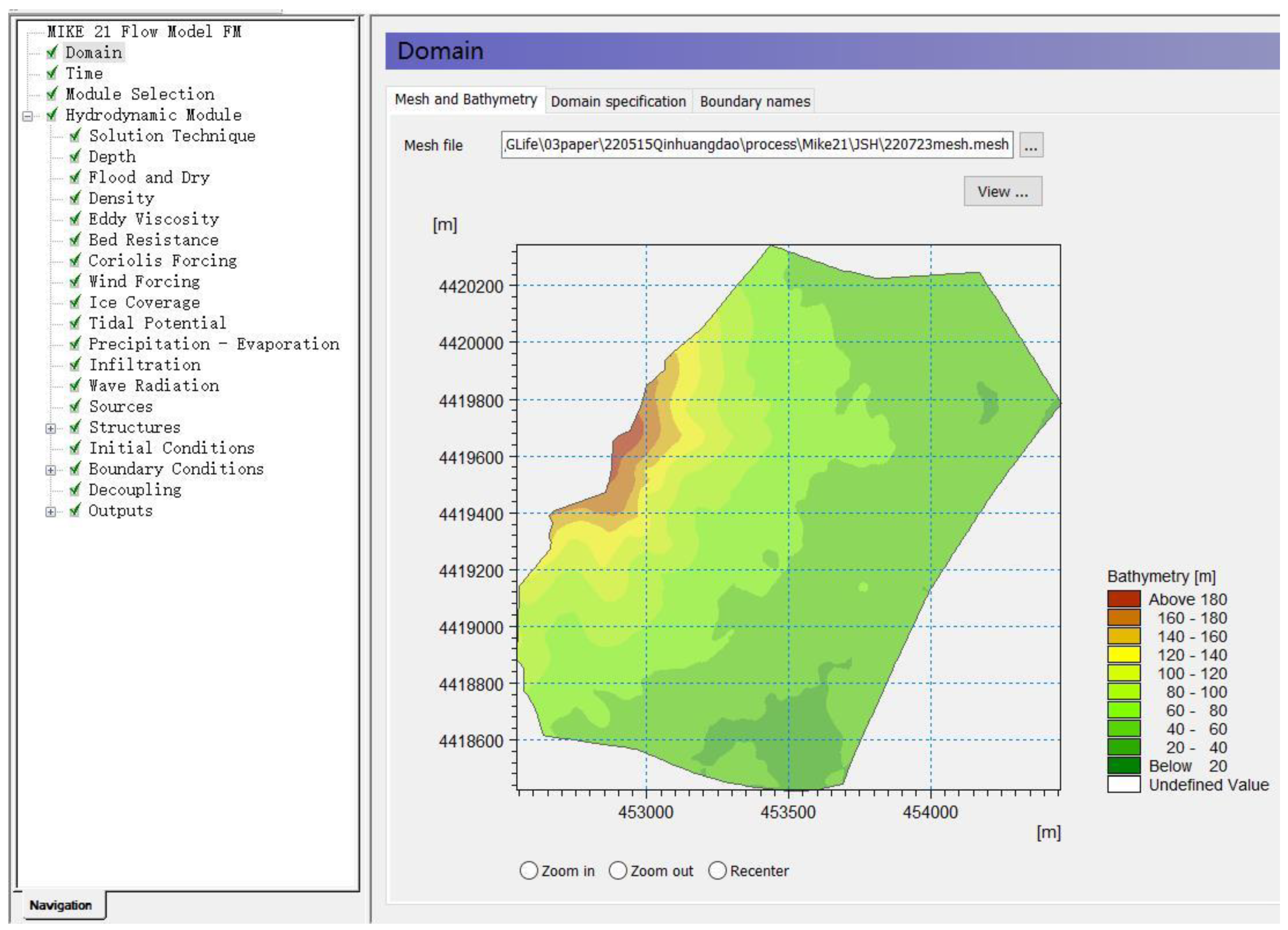



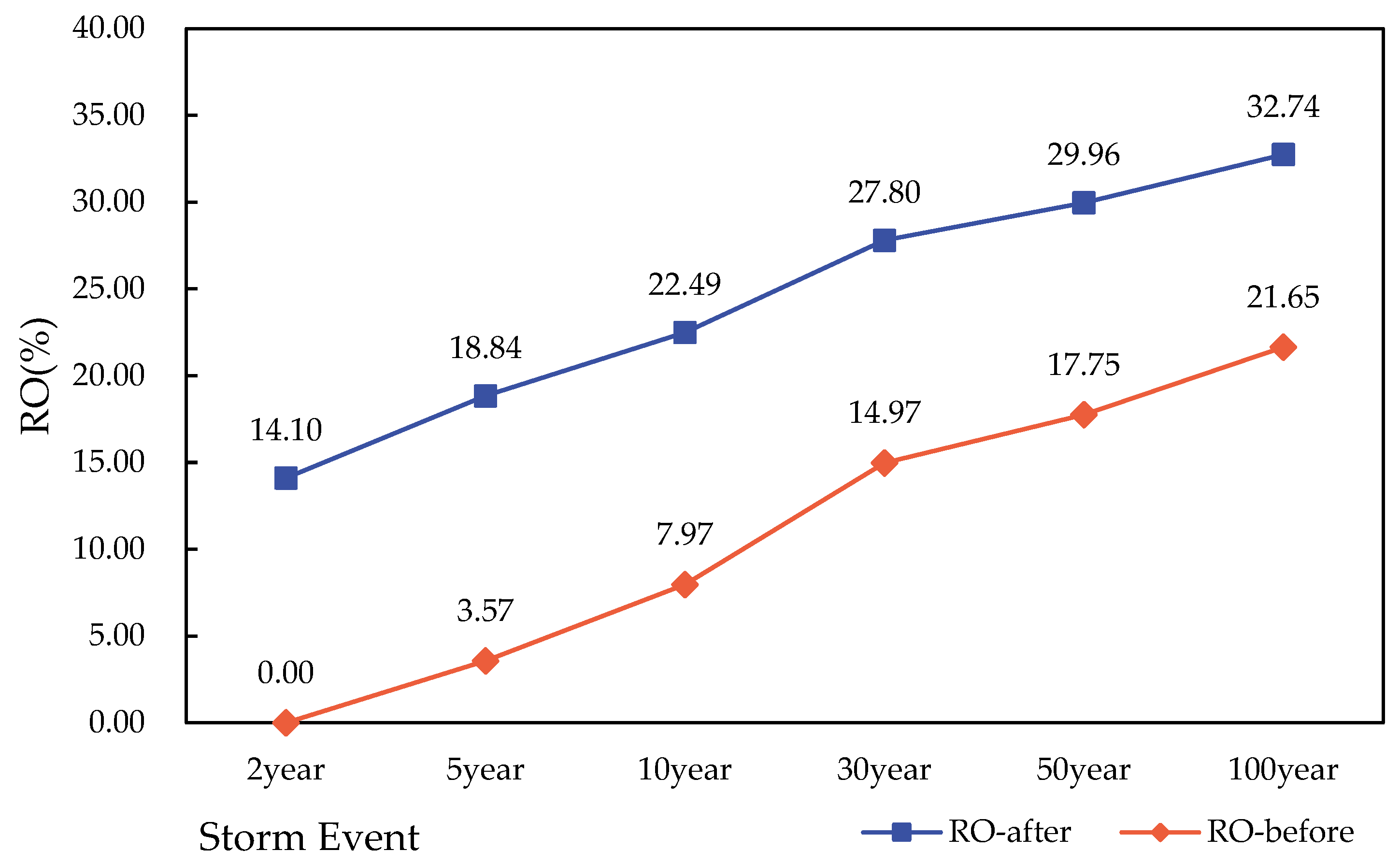
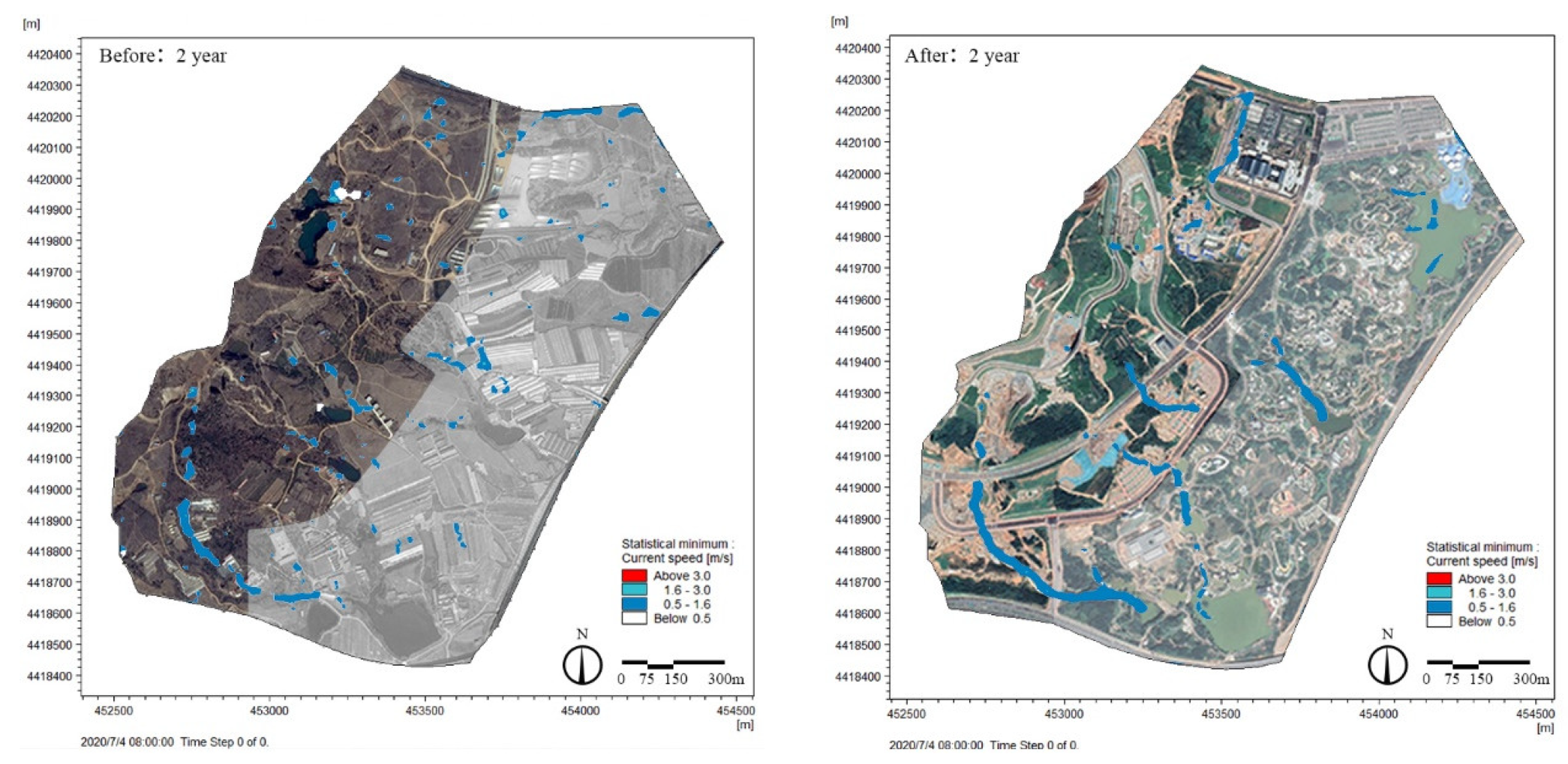

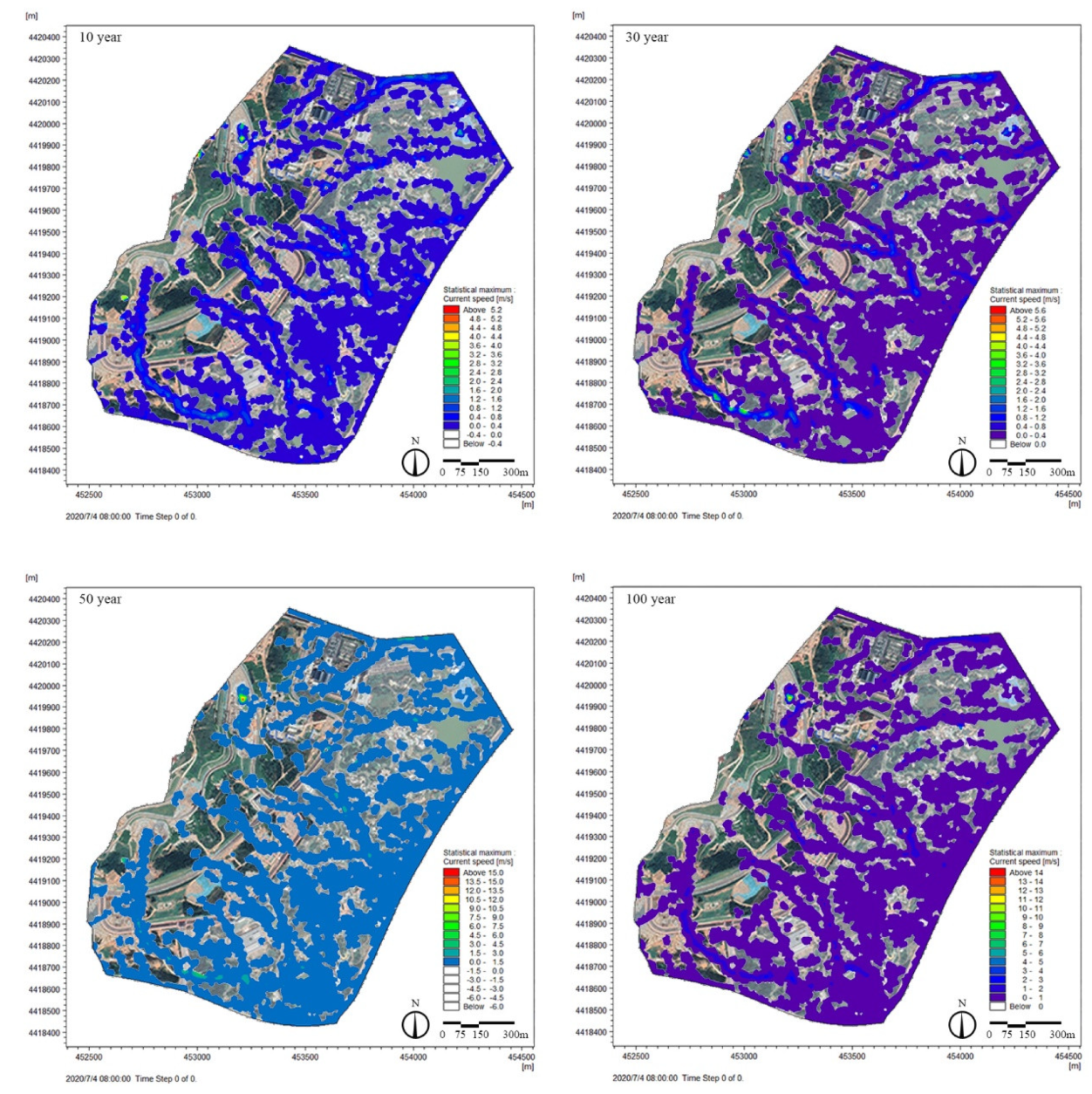


| Underlying Surface Type | Area (hm2) | Rainfall Runoff Coefficient | |
|---|---|---|---|
| External catchment | Mountain woodland | 99.70 | 0.40 |
| Asphalt road | 1.95 | 0.85 | |
| Internal catchment | Building roof | 6.99 | 0.80 |
| Impervious paving | 11.53 | 0.80 | |
| Permeable pavement | 8.74 | 0.30 | |
| Green space | 73.17 | 0.15 | |
| Landscape water | 19.73 | 1.00 | |
| Total | 221.81 | 0.40 | |
| Time | Monitor Flow (m3/s) | Simulation Flow (m3/s) |
|---|---|---|
| 8:00 p.m. | 0.00 | 0.1 |
| 8:30 p.m. | 0.00 | 0.15 |
| 9:00 p.m. | 0.12 | 0.16 |
| 9:30 p.m. | 0.38 | 0.48 |
| 10:00 p.m. | 0.74 | 0.66 |
| 10:30 p.m. | 1.01 | 1.15 |
| Rainfall | Peak Flow (m/s) | Time | |
|---|---|---|---|
| 2 years | Before | 6.95 | 2 h 40 min |
| After | 0.00 | None | |
| Difference (reduction rate) | 6.95 (100.00%) | - | |
| 5 years | Before | 11.45 | 2 h 45 min |
| After | 2.12 | 4 h 55 min | |
| Difference (reduction rate) | 9.33 (81.48%) | 2 h 5 min | |
| 10 years | Before | 16.59 | 2 h 50 min |
| After | 4.52 | 4 h 15 min | |
| Difference (reduction rate) | 12.07 (72.75%) | 1 h 25 min | |
| 30 years | Before | 26.26 | 2 h 50 min |
| After | 9.04 | 3 h 45 min | |
| Difference (reduction rate) | 17.22 (65.58%) | 55 min | |
| 50 years | Before | 31.01 | 2 h 50 min |
| After | 11.01 | 3 h 40 min | |
| Difference (reduction rate) | 20.00 (64.50%) | 50 min | |
| 100 years | Before | 37.63 | 2 h 50 min |
| After | 13.77 | 3 h 35 min | |
| Difference (reduction rate) | 23.86 (63.41%) | 45 min | |
| Rainfall | Before (m3) | After (m3) | Reduction Rates (%) |
|---|---|---|---|
| 2 years | 32,640 | 0 | 100.00 |
| 5 years | 53,750 | 10,180 | 81.06 |
| 10 years | 73,340 | 25,980 | 64.58 |
| 30 years | 108,640 | 58,510 | 46.14 |
| 50 years | 126,090 | 74,710 | 40.75 |
| 100 years | 151,140 | 99,930 | 33.88 |
Publisher’s Note: MDPI stays neutral with regard to jurisdictional claims in published maps and institutional affiliations. |
© 2022 by the authors. Licensee MDPI, Basel, Switzerland. This article is an open access article distributed under the terms and conditions of the Creative Commons Attribution (CC BY) license (https://creativecommons.org/licenses/by/4.0/).
Share and Cite
Lai, Y.; Lu, Y.; Ding, T.; Sun, H.; Li, X.; Ge, X. Effects of Low-Impact Development Facilities (Water Systems of the Park) on Stormwater Runoff in Shallow Mountainous Areas Based on Dual-Model (SWMM and MIKE21) Simulations. Int. J. Environ. Res. Public Health 2022, 19, 14349. https://doi.org/10.3390/ijerph192114349
Lai Y, Lu Y, Ding T, Sun H, Li X, Ge X. Effects of Low-Impact Development Facilities (Water Systems of the Park) on Stormwater Runoff in Shallow Mountainous Areas Based on Dual-Model (SWMM and MIKE21) Simulations. International Journal of Environmental Research and Public Health. 2022; 19(21):14349. https://doi.org/10.3390/ijerph192114349
Chicago/Turabian StyleLai, Yue, Yiyun Lu, Tingting Ding, Huiyi Sun, Xuanying Li, and Xiaoyu Ge. 2022. "Effects of Low-Impact Development Facilities (Water Systems of the Park) on Stormwater Runoff in Shallow Mountainous Areas Based on Dual-Model (SWMM and MIKE21) Simulations" International Journal of Environmental Research and Public Health 19, no. 21: 14349. https://doi.org/10.3390/ijerph192114349
APA StyleLai, Y., Lu, Y., Ding, T., Sun, H., Li, X., & Ge, X. (2022). Effects of Low-Impact Development Facilities (Water Systems of the Park) on Stormwater Runoff in Shallow Mountainous Areas Based on Dual-Model (SWMM and MIKE21) Simulations. International Journal of Environmental Research and Public Health, 19(21), 14349. https://doi.org/10.3390/ijerph192114349








